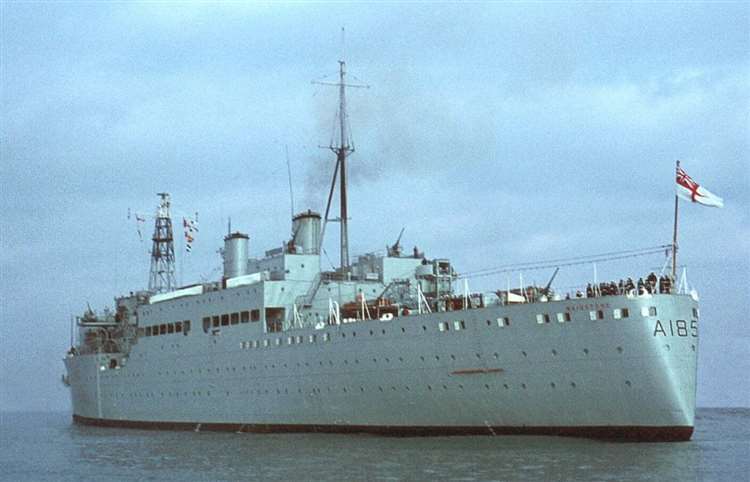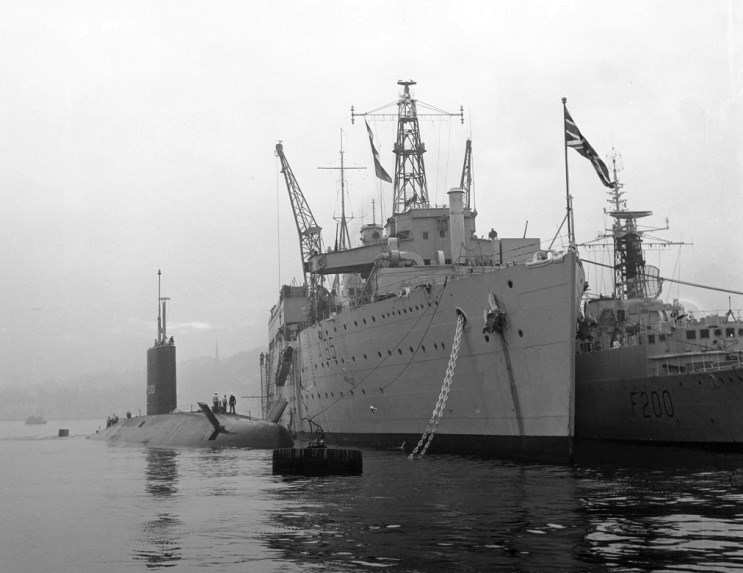- Yes
- No
Maidstone-class submarine depot ship, HMS Maidstone (A185)
Vehicle design and history:
HMS Maidstone was a submarine depot ship built by John Brown & company, Clydebank for the royal navy to support the increasing number of submarines coming into service in the mid 1930’s. The intent was for one large submarine depot ship to serve for each flotilla of 6 to 8 submarines, restocking their supplies of food, torpedos and fuel, along with general servicing, especially in distant stations like the Mediterranean Sea and the Pacific Far East. For this reason the ship was equipt with a myriad of services and equiptment, including a foundry, coppersmiths, plumbing and carpentry shops, heavy and light machine shops, electrical and torpedo repair shops and plants for charging submarine batteries. The ship was designed to serve as a mobile port, designed to tend to the maintenance needs of the submarines attatched to it, and as such it also possessed repair facilities needed to keep the subs assigned to it in full working order. In addition to this, the ship also possessed extendive salvage and diving equiptment, along with ammenities for the crews of the submarines it was servicing, including steam laundries, a cinema, hospital, chapel, two canteens, a bakery, barber shop, and a fully equipped operating theatre and dental surgery. This came together to create a rather large vessel, in order to accomadate all the roles it was assigned to, though unlike earlier designs HMS Maidstone was also well armed at launch, possessing 8 X 4.5 inch guns in 4 turrets and a pair of quad 40mm pom pom cannons. The pom poms would later be replaced by 8 X 40mm Bofors mounts Mk. VII.
Service History:
HMS Maidstone was laid down by John Brown & Company, Clydebank on the 17th of august 1936, launched the following year on october 21st 1937, and would enter commission on the 5th of may 1938. Her first year of service was rather bland before the war, with her serving as the depot ship to the ten submarines that made up the 1st submarine flotilla. This role would continue into the war, until in march of 1941, she would move to Gibraltar to begin supporting submarine operations in the Med. Furthing this role she would be assigned to Algiers Harbour in november of 1942, which at the time was the main Allied base in the Mediterranean. This would continue until november of 1943, where she was assigned to the eastern fleet, moving to Ceylon, until shifting to Fremantle in western Australia in 1944 to continue to support operations in the pacific. She would serve in this post until late 1945, where with the cessession of hostilities, she returned to the uk, docking on the way in the Selborne dry dock at Simonstown, South Africa. While on passage, she diverted to Macassar, to pick up 400 British naval prisoners of war from HMS Exeter, HMS Encounter and HMS Stronghold. She would ultimately arrive at Portsmouth in november of 1945. During the war, Maidstone was also adopted by the Borough of Maidstone as part of Warship Week, with the adoption plaque now held by the National Museum of the Royal Navy in Portsmouth.
HMS Maidstone’s service would not end with the second world war, and in 1946 she became the mother ship to the 2nd and 7th Submarine Flotillas. The 2nd Flotilla was simply operational boats, with the 7th being a boats on trials or training submarines. In this role Maidstone had a semi-permanent mooring off monkey island, Portland, though she would often be put to sea to support her subsidiary ships. Interestingly during this time, she had to briefly call at Corunna to land a sick crewman, making this the first, if not official visit of a british warship to a spanish harbour since the end of teh spanish civil war. In 1953, HMS Maidstone also took part in the fleet review to celebrate the Coronation of Queen Elizabeth II.
The next major event in HMS Maidstone’s service occured on the 16th of june 1955, when after loading an pair of experimental torpedos on HMS Sidon, the day prior the submarine suffered a catastrophic explosion, causing it to sink in Portland harbor. Maidstone was soon alongside the stricken submarine around 20 minutes after the explosion, which had occured in the forward torpedo compartment. A rescue party from Maidstone boarded Sidon, and managed to save a number of crew, though 13 died in the incident. A week later the submarine was raised, and the accident was found to have been caused by the high test peroxide in the “Fancy” torpedo. The Surgeon Lieutenant Charles Rhodes from HMS Maidstone was posthumously awarded the Albert medal for his part in the rescue.
In 1956 Maidstone became the flagship of the commander in chief of the home fleet, because of this she accompanied the training aircraft carrier HMS Ocean on a visit to Helsinki in 1957, an action protested by the soviet union. Two years later, HMS Maidstone received an extensive refit, allowing her to accomodate the needs of nuclear submarines, along with the 2nd submarine flotilla, when she was moved to Devonport. This role would change in 1961, when she was moved to Faslane, where she served as the mothership for the 10th and 3rd submarine squadrons. By 1968 the ship underwent preparations to be permenatly retired, with the Norwegian navy considering buying it, along with HM prison service, which deemed the facilities onboard were only suitable for 50 or so prisoners. These plans would be discarded though, and in 1969 HMS Maidstone was refitted and re-commisioned as an accommodation ship for 2000 troops and sent to belfast to serve as a barracks for the swelling number of british security forces in the area. This initial mission would shift in 1971, when she was used in operation demetrius as a place to hold internees without trial including Gerry Adams. The holding area composed two bunkhouses at teh stern of the vessel, along with a mess room and a deck for excersise. This desk was surrounded by a 3m high barbwire fence, which along with the ship being moored 20 feet from land on a guarded jetty was deemed more than sufficient to keep the prisoners contained. Of course this was not the case, and on the 17th of january 1972 seven members of the provisional IRA sucessfully escaped the ship, swimming about 270m through icy water to evade the army and police, after which they later held a press conference.
After this the ship would continue to house prisoners until early 1975, though she remained in belfast, as part of the Royal Naval Operation in Northern Ireland, in order to be used as emergency short notice accommodation for the army, if significant regional reinforcements were required, though this never came about. Due to its aging condition, and lack of need, Maidstone was sold for scrap, and would be broken up on the 23rd of may 1978 at the Thos. W. Ward scrapyard in Inverkeithing. The ship’s bell would be removed before the scrapping and is now located at the Maidstone Grammar School, where it is rung to signify the start of assemblies.
Specifications:
Displacement: 8,900 tons
Length: 497 ft (151 m)
Beam: 73 ft (22 m)
Speed: 17 knots (31 km/h; 20 mph)
Complement: 1,167 men
Armament: 8 × 4.5 in (110 mm) DP guns (4×2)
8 × single 40 mm Bofors mounts Mk. VII
Additional Historical Pictures:
Image giving a clear view of the 40mm mounts on the rear of the vessel:
Hide contents
Photo of HMS Maidstone tending to HMS Dreadnought:
Hide contents
Two photo’s showing HMS Maidstone tending to a pair of porpoise-class submarines:
Hide contents
Sources:
- The mixed fortunes of the submarine depot ship HMS Maidstone and its time as a prison hulk for IRA internees (Brief history of the ship and historical pictures)
- HMS Maidstone (1937) - Wikipedia (wikipage for the ship)
- https://www.anphoblacht.com/contents/28241 (Article highlighting the prison escape from HMS Maidstone)
- HOME FLEET EXERCISE WITH THE ROYAL CANADIAN NAVY'S ATLANTIC FLEET [Allocated Title] | IWM Film (Historical footage of HMS Maidstone during operations)
- HMS Maidstone (F 44) of the Royal Navy - British Submarine Depot Ship of the Maidstone class - Allied Warships of WWII - uboat.net ( additional service history)
Edited January 25 by nathanclawfish




